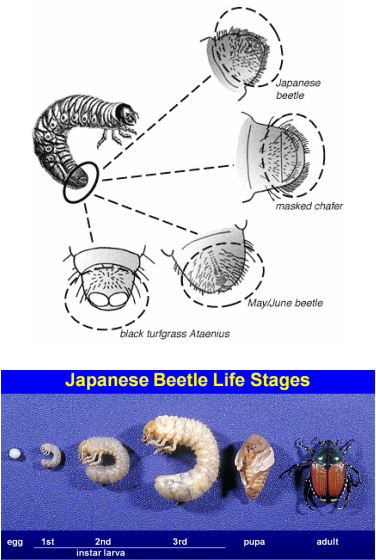Japanese Beetle
A Bit About Grubs

Japanese beetle grubs or larva are less than 25 mm long at full maturity. They are white with a yellow head and are curled into a 'C' shape. The only thing that distinguishes the Japanese beetle grub from others is that there is a distinct 'V' shape of the last two rows of spines on the last body segment (Canadian Food Inspection Agency, 2009).
Japanese beetles like to lay their eggs in moist grassy soil;golf courses and your yard are favorites because they are watered often. Most eggs are laid between the end of June and mid-August. Eggs hatch after about 8 to 14 days. This starts the first of three instar stages which lasts about 17 to 25 days. During this time the grub moves up to the root level of the grasses and begins to feed on the roots. The second instar stage takes about 18 to 45 days. All grubs should be in the third instar stage by the end of September. In October they burrow further down into the soil for the winter. As the temperature begins to rise in the spring the grubs move back to the root zone of the grasses. In about late April the grubs from a pupa in about 1 to 3 inches of soil. The adult form of the Japanese beetle emerges from the ground at the end of June or beginning of July (Shetlar, 2001).
Japanese beetles like to lay their eggs in moist grassy soil;golf courses and your yard are favorites because they are watered often. Most eggs are laid between the end of June and mid-August. Eggs hatch after about 8 to 14 days. This starts the first of three instar stages which lasts about 17 to 25 days. During this time the grub moves up to the root level of the grasses and begins to feed on the roots. The second instar stage takes about 18 to 45 days. All grubs should be in the third instar stage by the end of September. In October they burrow further down into the soil for the winter. As the temperature begins to rise in the spring the grubs move back to the root zone of the grasses. In about late April the grubs from a pupa in about 1 to 3 inches of soil. The adult form of the Japanese beetle emerges from the ground at the end of June or beginning of July (Shetlar, 2001).

